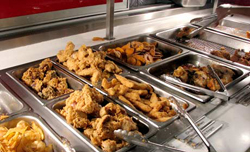Archive
Your Chicken Takes a Road Trip or Dumpster Diving is Not Just a Sport

The humble chicken is one of America’s basic dinner and lunch entrees along with being a popular source of protein. Some individuals that do not want to eat Beef or Pork for the most part do not seem to have a problem consuming chicken. So it seems to me that this food product is as good a place as any to begin our journey through some of the weirder practices in America’s family run grocery stores and supermarkets.
That chicken or chicken based product that you see in your local grocery store had already traveled many miles before it found itself on the shelf in your local supermarket. It’s life began in a breeding cage in some massive Chicken Gulag where it was required to stand for long periods of time hyped up on some insane chemical cocktail mix that the producers called feed. From the time it begins its life a chicken has been selected for a particular purpose in the Retail Food Chain such as that of a fryer, plump boneless breast, nuggets etc. Science and technology has helped the food industry to maximize the chickens contribution to their profit structure and our daily diet.

So once this Roger Clemens bred chicken was determined to be the right size for what it was designed for it was killed, stripped of its feathers, dignity, processed, packaged and put on a truck for parts unknown. For the purposes of our story its destination is a family owned grocery store somewhere in the United States.
For most people the packaged chicken will be picked up from a store shelf by the consumer, scanned, bagged and put into their mini van or SUV where it will finally reside in the refrigerator ready to be used for the family meal. In some of the grocery stores that you will read about on this blog this is only the beginning of the Chicken’s Road Trip.
Some years back I was working for a grocery store chain and it was lunch time so the suggestion was made that all of us go to the store’s deli department to get some lunch and continue working at our desks. Having worked in other family run grocery stores I was filled with a bit of trepidation because their basic sanitary practices sometimes leave a lot to be desired. Anyway I hid my fears of a Biological Attack on my body and followed along with everyone else to the store’s deli department.

As we were all gazing at the display cases filled with assortments of meat, cheese, salads and already prepared foods my mind felt like it was being teased by the overall appearance and presentation of the food products neatly arranged before me. My stomach began to growl quietly and I felt this overwhelming urge to make a decision so that I could savor the taste of these visually appealing dishes. Suddenly the clerk behind the counter ask me what I would like and I quickly responded “Chicken Salad please”.
“No, do not get that” one of my fellow lunch mates sternly said to me. No I asked – why? He said “don’t you know where the Chicken Salad comes from?”. The storage cooler I naively answered. He started laughing and then began to tell me of how that Chicken Salad got into the display case.
First of all this store sells Rotisserie Chickens he said. I looked at him like why are you talking to me like I am an idiot almost every store does? Anyway he said that this store had a policy to use chickens in the meat case that have gone out of date in the deli department to boost its profitability. I thought for a moment and figured well I was always told that if a product has a Sell by Date it just means that the customer should have bought it by that point not necessarily used it – they have a few days at home for that. Well I kept my thoughts to myself while my lunch mate continued with the origins of the chicken salad story.

Normally he said the deli brings in special chickens from distributors to make Rotisserie Chickens or Fried Chickens in this store. These distributor supplied chickens tend to be injected and pre-seasoned and will be the source for a future blog entry. However one of the owners son-in-laws of this small chain of stores was passing the trash door in the back of one of the stores some time back and saw someone from the meat department throwing away some chickens. The story goes that this son-in-law who had witnessed this brazen act of waste and just about jumped through the Trash Door to grab some of the chickens before they landed in the outside trash container. Ever smelled the chute of a trash disposal in a supermarket? Because of this son-in-laws possible background in waste disposal at some previous job he saw no reason why these dated chickens could not be rescued from the trash bin and actually used for something else in the store.
It was at that point in history that this grocery store decided that they could take the dated chickens from the meat department and use them in its deli department. Okay other than reaching into the trash chute or digging chickens out of a trash can what is the harm in using a chicken who’s sell by date is yesterday? Boy was I in for a shock.
Remember that I had asked for the Chicken Salad? Well what was wrong with that I thought. My lunch mate now continued the story of the Traveling Chicken. He said that the store will fry some of the chickens that are “rescued” and then sell them in the deli department. These pieces of Fried Chicken will usually be kept in the case for a day or so. Okay I thought so far it is not like the Fried Chicken will be rancid smelling besides I ordered the Chicken Salad. Then he said if the Fried Chicken is still there the next day it will be pulled from the display case and then that meat from those chickens will be cut up into chunks to use in the Chicken Salad. Okay now I was getting scared. Then he said that some portions of this “rescued” Chicken Salad might sit in the display case for purchase for another couple of days. Wow I thought that Chicken Salad might have been out of date for a week or so before I eat it. No I was saying to myself I do not want the Chicken Salad. Too late the clerk was already putting the Chicken Salad into a container for me to eat.
My lunch mate started to chuckle and said “do you know what happens to the Chicken Salad that is not sold?”. Sheepishly I replied no what happens to it? Well he said the old Chicken Salad is then put in a colander and all of the mayonnaise along with the seasoning is rinsed off and the chicken is then used for anything from a Chicken Ala-King entree to Chicken Soup.
Now I felt the insides of my stomach rumbling and my mouth felt like it does after one has vomited yet nothing comes out you know the dry heaves? Then I realized that what I had ordered was not such a bad selection after all because I did get the Chicken Soup!
AB
Blog Entry Foot Notes and Perspective Comments:
– Most grocery stores today procure their deli salads and prepared foods from either an outside distributor or they are made in a companies central commissary. However there is still a significant percent of stores that make their own salads, entrée and take out foods in-store.
– The ability to hold the temperature of a refrigerated display case or a storage box in supermarket is an important factor in keeping perishable food safe for the consumer.
– Case maintenance and electrical usage is a large expense in every supermarket operation today.
– One university study stated that Supermarkets in the United States account for 5% of the total amount of electricity used annually.
– All grocery stores are subject to random health department inspections from local government or state agencies along with investigations initiated by consumers.
– It is not in the interest of any retail food establishment to endanger their customers health by selling contaminated or spoiled food products.
– The number of reported food related illness or contamination incidents varies from location to location.
– Retail Supermarkets operate on one of the smallest net profit percentages of almost any industry in the United States.
– Next to the cost of goods sold in a typical supermarket or grocery store labor is the next largest expense of a retail food operation.
– The stories in this Blog entry are true.
Copyright @ 2010 Supermarket Stories